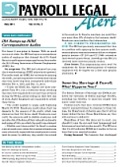 Good news for employers: The U.S. Department of Labor has abandoned its inflexible, six-part test for determining whether interns qualify as employees (see old test in box below). Those rules from 2010 said internships at for-profit companies “will most often be viewed as employment.”
Good news for employers: The U.S. Department of Labor has abandoned its inflexible, six-part test for determining whether interns qualify as employees (see old test in box below). Those rules from 2010 said internships at for-profit companies “will most often be viewed as employment.”
In its place, the DOL in January 2018 issued a new, more flexible test that makes it easier to legally create unpaid internship programs as long as the answers to seven questions show (on balance) that the intern benefits more from the relationship than the employer does.
This new “primary beneficiary” test make it vital that employers establish clear written policies and agreements that structure the program so that all seven factors lean toward an internship.
The new seven-question test focuses on the “economic realities” of internships. The purpose isn’t to earn money but to receive educational experience that schooling doesn’t provide.
Going forward, to consider whether a person is an intern or employee, the DOL and courts will consider the extent to which:
1. The intern and the employer clearly understand that there is no expectation of compensation.
2. The internship provides training similar to that available in an educational environment.
3. The internship is tied to the intern’s formal education by integrated coursework or receipt of academic credit.
4. The internship timing corresponds to the academic calendar.
5. The internship lasts only as long as beneficial learning takes place.
6. The intern’s work complements, rather than displaces, the work of paid employees.
7. The intern and employer understand the internship is conducted without entitlement to a paid job at the internship’s end.
In recent years, courts have seen a wave of lawsuits from interns demanding pay. Several circuits had rejected the DOL’s inflexible, all-or-nothing approach, favoring some version of this primary-beneficiary test. This new DOL seven-question test aims to conform to those court rulings.
The DOL says courts have described the “primary beneficiary test” as a flexible test, and no single factor is determinative. Accordingly, whether an intern or student is an employee under the FLSA necessarily depends on the unique circumstances of each case.
Online resource: Read the U.S. Department of Labor’s Fact Sheet #71: Internship Programs Under The Fair Labor Standards Act.

